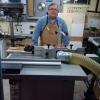I am new to woodworking - just got my first table saw (Bosch 4100-09). The purpose (at least for now) is to rip 1.5" strips of 1.5" thick MDF. Most likely I will be doing this with 3' x 4' sheets (in other words making 1.5" MDF squares 4' long). I watched youtube demos of the GRR-Ripper and it looks like a great way to do that. The only issue is in those videos the stock that was used for the demostration was fairly short and narrow. If I want to rip narrow stock out of 4'x4' sheets is the GRR-Ripper a good way to do it? If yes, how exactly do I do that if my whole table is less than 3' wide and the distance from the edge of the table to the blade is like a foot or so? Do I build an additional infeed/outfeed tables? If yes, how do I push the woodpiece past the blade without leaning over the additional infeed table dangerously close to the blade? Anybody's got a video of using GRR-Ripper with 4'x4' sheets or something like that (preferably cutting narrow stock)?
Is there a difference between GRR-Ripper and Gripper push block?




 Reply With Quote
Reply With Quote








